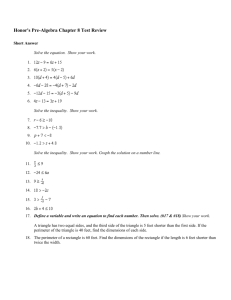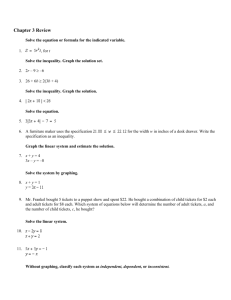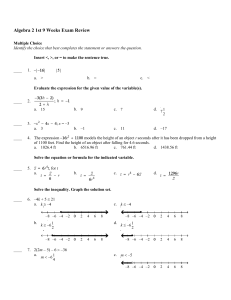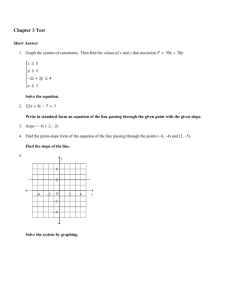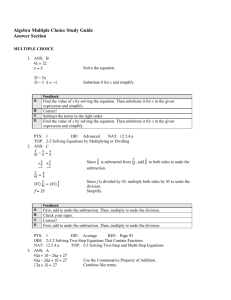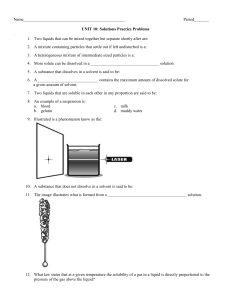Algebra 2 Semester 1 Review -- Linear Equations
advertisement
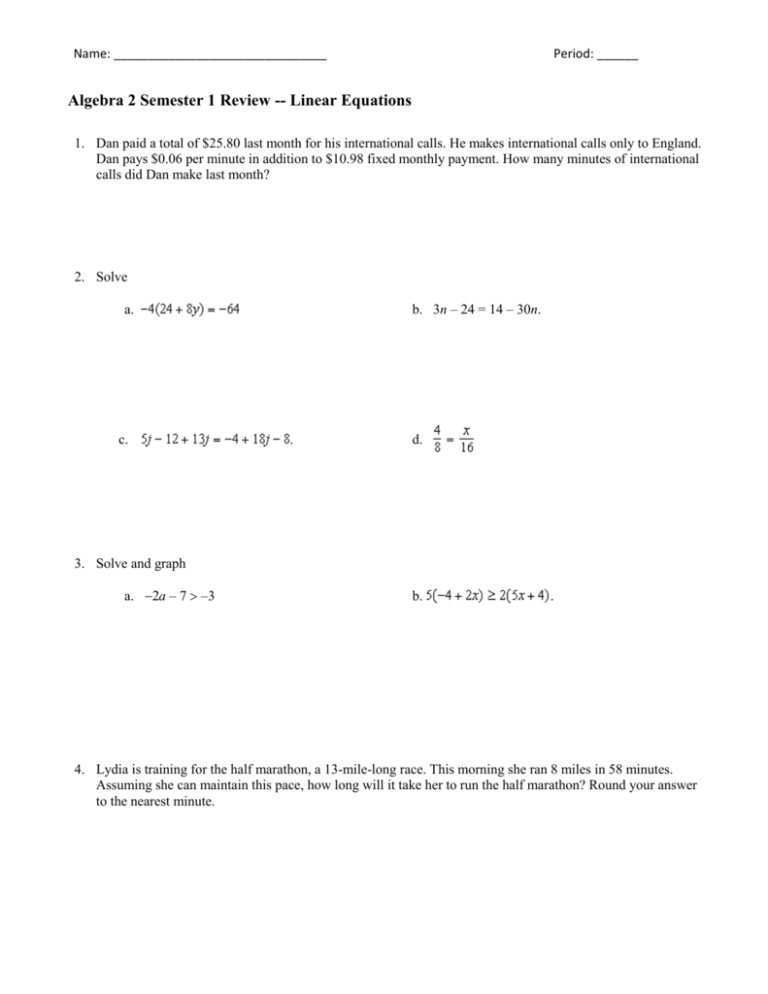
Name: _______________________________
Period: ______
Algebra 2 Semester 1 Review -- Linear Equations
1. Dan paid a total of $25.80 last month for his international calls. He makes international calls only to England.
Dan pays $0.06 per minute in addition to $10.98 fixed monthly payment. How many minutes of international
calls did Dan make last month?
2. Solve
b. 3n – 24 = 14 – 30n.
a.
c.
.
d.
3. Solve and graph
a. 2a – 7 –3
b.
.
4. Lydia is training for the half marathon, a 13-mile-long race. This morning she ran 8 miles in 58 minutes.
Assuming she can maintain this pace, how long will it take her to run the half marathon? Round your answer
to the nearest minute.
Name: _______________________________
Period: ______
5. A sawyer (person who cuts down trees) wants to know the height of a tree. The sawyer measures the shadow
of his friend, who is 5 feet tall and standing beside the tree, and measures the shadow of the tree. If his
friend’s shadow is 12 feet long and the tree’s shadow is 60 feet long, how tall is the tree?
6. Could the following set of data represent a linear function? Why or why not?
x
0
1
2
3
f(x)
1
0
–1
–2
7. Find the intercepts of
, and graph the line.
8. Write the function
in slope-intercept form. Then graph the function.
9. Determine if
vertical or horizontal. Then graph.
10. Write the equation of the graphed line in slope-intercept form.
y
5
4
3
2
1
–5
–4
–3
–2
–1
–1
–2
–3
–4
–5
1
2
3
4
5
x
Name: _______________________________
Period: ______
11. Find the slope of the line that passes through the points (1, 3) and (9, 7).
12. In slope-intercept form, write the equation of the line that contains the points in the table.
x
y
1
2
5
4
9
6
13
13. After the first three miles, the cost of a taxi ride is a linear function of the trip length. Express the taxi cost as
a function of the trip length. A 5-mile ride costs $5.00 and a 10-mile ride costs $8.75. Write an equation to
express the relationship between the taxi cost and the trip length.. How much does a 16-mile ride cost?
14. Graph the inequality
15. Graph 16x + 8y > –32 using intercepts. In other words, find your intercepts in below and use them to graph
the inequality.
16. Solve
for y. Graph the solution.
17. Solve the compound inequality. Then graph the solution set.
or
18. Solve the equation
.
Name: _______________________________
Period: ______
19. The data set shows the amount of funds raised and the number of participants in the fundraiser at the Family
House organization branches. Make a scatter plot of the data with number of participants as the independent
variable. Then, find the correlation coefficient and the equation of the line of best fit and draw the line.
Family House Fundraiser
6
10 15 20 25 13 15 18
450 550 470 550 650 600 600 650
Number of participants
Funds raised ($)
20 .Estimate the value of r for the scatter plot.
y
12
10
8
6
4
2
–10 –8
–6
–4
–2
–2
2
4
6
8
10
x
–4
–6
–8
–10
–12
a. –1.00
b. –2.50
c. 2.50
d. 1.00
Name: _______________________________
Period: ______
Algebra 2 Semester 1 Review -- Linear Equations
Answer Section
SHORT ANSWER
1. ANS:
247 minutes
Let x represent the number of international call minutes Dan made last month.
number of
fixed monthly
cost per
total monthly
plus
times
international
=
payment
minute
payment
call minutes
10.98
+
0.06
•
x
=
25.80
Solve
.
Subtract 10.98 from both sides of the equation.
Divide both sides by 0.06 to find x.
PTS: 1
DIF: Average
REF: Page 91
OBJ: 2-1.1 Application
NAT: 12.5.4.c
TOP: 2-1 Solving Linear Equations and Inequalities
KEY: solve | linear equation
2. ANS:
= –1
Distribute –4.
Add to both sides.
Divide by
.
PTS: 1
DIF: Basic
REF: Page 91
OBJ: 2-1.2 Solving Equations with the Distributive Property
TOP: 2-1 Solving Linear Equations and Inequalities
3. ANS:
5
n = 1 33
NAT: 12.5.4.a
KEY: solve | linear equation | parentheses
First, collect all variable terms on one side and all constant terms on the other side. Then, isolate the variable.
PTS: 1
DIF: Average
REF: Page 92
OBJ: 2-1.3 Solving Equations with Variables on Both Sides
NAT: 12.5.4.a
TOP: 2-1 Solving Linear Equations and Inequalities
KEY: addition | division | multiplication | multi-step equations | solving | subtraction
4. ANS:
The solution set is all real numbers, or .
Simplify.
Identity. The solution set is all real numbers.
Name: _______________________________
Period: ______
PTS: 1
DIF: Average
REF: Page 92
OBJ: 2-1.4 Identifying Identities and Contradictions
TOP: 2-1 Solving Linear Equations and Inequalities
5. ANS:
a –2
–10 –8
–6
–4
–2
0
2
4
6
8
NAT: 12.5.4.a
10
To isolate the variable, first undo the addition or subtraction. Then, undo the multiplication by dividing each
side of the inequality by the coefficient of the variable. If the coefficient is negative, reverse the inequality
symbol. Next, graph the solution.
Remember, a “>” or “<” graph has an open circle at that value. A “ ” or “ ” graph has a closed circle at that
value.
A “>” or “ ” graph has an arrow to the right, and a “<” or “ ” graph has an arrow to the left.
PTS: 1
DIF: Basic
REF: Page 93
OBJ: 2-1.5 Solving Inequalities
NAT: 12.5.4.c
TOP: 2-1 Solving Linear Equations and Inequalities
KEY: solving | two-step inequality
6. ANS:
The inequality has no solution. The solution set is the empty set.
–10 –9
–8
–7
–6
–5
–4
–3
–2
–1
0
1
2
3
4
5
6
7
8
9
10
9
10
Use the Distributive Property.
Isolate x. Then simplify.
Contradiction.
The inequality has no solution. The solution set is the empty set.
–10 –9
–8
–7
–6
–5
–4
–3
–2
–1
0
1
2
3
4
5
6
7
8
PTS: 1
DIF: Advanced
NAT: 12.5.4.c
TOP: 2-1 Solving Linear Equations and Inequalities
7. ANS:
x=8
Set the cross products equal.
Divide both sides.
PTS: 1
DIF: Basic
REF: Page 97
OBJ: 2-2.1 Solving Proportions
Name: _______________________________
Period: ______
NAT: 12.1.4.c
TOP: 2-2 Proportional Reasoning
8. ANS:
94 min
Use a proportion to find the expected time.
KEY: proportion | cross products
Write both ratios in the form
.
Find the cross products.
Simplify.
Round to the nearest minute.
x
x
PTS: 1
DIF: Average
REF: Page 98
NAT: 12.1.4.c
TOP: 2-2 Proportional Reasoning
9. ANS:
25 feet
Sketch the situation.
OBJ: 2-2.3 Application
x ft tree
5 ft friend
12 ft
60 ft
The heights and shadows form similar triangles.
So the sawyer can use proportions to find the
height x of the tree.
Find the cross products.
Divide both sides by 12.
The tree is 25 feet tall.
PTS: 1
DIF: Average
REF: Page 99
NAT: 12.3.2.e
TOP: 2-2 Proportional Reasoning
10. ANS:
Yes, the data set could represent a linear function.
If the rate of change,
OBJ: 2-2.5 Application
, is constant, then the data set is linear. If the rate of change is not
constant, then the data set is not linear.
PTS: 1
DIF: Average
REF: Page 105
NAT: 12.5.1.e
TOP: 2-3 Graphing Linear Functions
11. ANS:
x-intercept: –2, y-intercept: –2
OBJ: 2-3.1 Recognizing Linear Functions
KEY: function | input | output
Name: _______________________________
Period: ______
y
10
8
6
4
2
–10 –8
–6
–4
–2
–2
2
4
6
8
10
x
–4
–6
–8
–10
Find the x-intercept:
Substitute 0 for y.
The x-intercept is –2.
Find the y-intercept:
Substitute 0 for x.
The y-intercept is –2.
PTS: 1
DIF: Average
REF: Page 106
OBJ: 2-3.3 Graphing Lines Using the Intercepts
NAT: 12.5.4.c
TOP: 2-3 Graphing Linear Functions
KEY: linear equation | solving | x-intercept | y-intercept
12. ANS:
y
10
8
6
4
2
–10 –8
–6
–4
–2
–2
2
–4
–6
–8
–10
Solve for y first in
slope:
, y-intercept:
.
4
6
8
x
Name: _______________________________
Plot the point
points.
. Then move down 1 and right 2 to find another point. Draw a line connecting the two
y
10
8
6
4
2
–10 –8
–6
–4
–2
–2
–4
2
4
6
(0, –2)
(2, –3)
8
10
x
–6
–8
–10
PTS: 1
DIF: Average
REF: Page 107
OBJ: 2-3.4 Graphing Functions in Slope-Intercept Form
NAT: 12.5.2.a
TOP: 2-3 Graphing Linear Functions
KEY: slope-intercept form | graph
13. ANS:
The line is vertical.
y
5
4
3
2
1
–5
–4
–3
–2
Period: ______
–1
–1
–2
–3
–4
–5
1
2
3
4
5
x
Name: _______________________________
Period: ______
This is a vertical line located at the x-value –2.
y
5
4
3
2
1
–5
–4
–3
–2
–1
–1
1
2
3
4
5
–2
–3
–4
–5
PTS: 1
DIF: Average
REF: Page 108
OBJ: 2-3.5 Graphing Vertical and Horizontal Lines
NAT: 12.5.4.c
TOP: 2-3 Graphing Linear Functions
KEY: vertical line | horizontal line | graph
14. ANS:
Step 1 Identify the y-intercept.
The y-intercept b is at 4.
Step 2 Find the slope.
Choose any two convenient points on the line, such as (0, 4) and (1, 1).
Count from (0, 4) to (1, 1) to find the rise and the run.
The rise is
units and the run is 1 unit.
Slope is
Step 3 Write the equation in slope-intercept form.
y = mx + b
and
The equation of the line is
.
PTS: 1
DIF: Average
REF: Page 115
OBJ: 2-4.1 Writing the Slope-Intercept Form of the Equation of a Line
NAT: 12.3.4.d
TOP: 2-4 Writing Linear Functions
15. ANS:
Let
be (1, 3) and
be (9, 7).
Use the slope formula.
The slope of the line is .
x
Name: _______________________________
Period: ______
PTS: 1
DIF: Basic
REF: Page 116
OBJ: 2-4.2 Finding the Slope of a Line Given Two or More Points
TOP: 2-4 Writing Linear Functions
16. ANS:
First, find the slope. Let
be
and
be
.
Next, choose a point to find the equation of a line.
Using
:
Substitute.
Distribute. Simplify.
The equation of the line is
PTS: 1
NAT: 12.5.2.a
17. ANS:
.
DIF: Average
REF: Page 117
TOP: 2-4 Writing Linear Functions
OBJ: 2-4.3 Writing Equations of Lines
18
Cost of taxi ride ($)
16
14
12
10
8
6
4
2
2
4
6
8
10
12
14
16
18
Number of miles
The 16-mile ride costs $13.25.
Step 1 Find the slope using the points (5, 5) and (10, 8.75).
Step 2 Use the point-slope form to find the equation for the line.
Step 3 Graph the line.
Name: _______________________________
Period: ______
18
Cost of taxi ride ($)
16
14
12
10
8
6
4
2
2
4
6
8
10
12
14
16
18
Number of miles
Step 4 Find y when
.
PTS: 1
NAT: 12.4.1.b
18. ANS:
DIF: Average
REF: Page 118
TOP: 2-4 Writing Linear Functions
OBJ: 2-4.4 Application
y
5
4
3
2
1
–5
–4
–3
–2
–1
–1
1
2
3
4
5
x
–2
–3
–4
–5
The boundary line is
, which has a y-intercept of –2 and a slope of . Draw the boundary line
dashed because it is not part of the solution. Then shade the region above the boundary line to show
.
PTS: 1
DIF: Basic
REF: Page 124
OBJ: 2-5.1 Graphing Linear Inequalities
NAT: 12.5.2.a
TOP: 2-5 Linear Inequalities in Two Variables
KEY: linear inequality | graph
19. ANS:
Name: _______________________________
Period: ______
y
5
4
3
2
1
–5
–4
–3
–2
–1
–1
1
2
3
4
5
x
–2
–3
–4
–5
Substitute 0 for y to find the x-intercept.
Simplify.
Substitute 0 for x to find the y-intercept.
Simplify.
Plot the intercepts at (–2, 0) and (–4, 0) on the graph. Because “>” is used and the y-coefficient is positive,
make the line dashed and shade above the line.
PTS: 1
DIF: Average
REF: Page 125
OBJ: 2-5.2 Graphing Linear Inequalities Using Intercepts
TOP: 2-5 Linear Inequalities in Two Variables
20. ANS:
; At least 31CDs.
NAT: 12.5.4.a
KEY: linear inequality | graph
y
72
64
56
48
40
32
24
16
8
8
16
24
32
40
48
56
64
72
80 x
The total profit on the records and posters must be greater than or equal to $200.
Poster times
profit
3
number of
posters sold
plus CD profit times number of is greater than
CDs sold
or equal to
+
5
average
profit
200
Name: _______________________________
An inequality that models this problem is
Period: ______
.
Find the intercepts to graph the boundary line. They are at (0, 40) and ( , 0).
Shade the region that is above the boundary line that is in the first quadrant.
To find how many CDs must be sold if 15 posters are sold, plug 15 into the inequality and solve for y.
PTS: 1
DIF: Average
REF: Page 126
OBJ:
NAT: 12.5.4.a
TOP: 2-5 Linear Inequalities in Two Variables
KEY: linear inequality | graph
21. ANS:
2-5.3 Problem-Solving Application
y
5
4
3
2
1
–5
–4
–3
–2
–1
–1
1
2
3
4
5
x
–2
–3
–4
–5
Multiply both sides by .
Subtract from both sides.
Multiply by , and reverse the inequality symbol.
Graph the solution. Use a dashed line for inequalities using >, and shade above the line.
PTS: 1
DIF: Average
REF: Page 127
OBJ: 2-5.4 Solving and Graphing Linear Inequalities
TOP: 2-5 Linear Inequalities in Two Variables
22. ANS:
NAT: 12.5.4.a
KEY: linear inequality | graph
Name: _______________________________
Period: ______
y
6
4
2
–6
–4
–2
2
4
x
6
–2
–4
–6
Step 1 Simplify the inequality.
Change the inequality symbol when multiplying by a negative number.
Step 2 Find the intercepts of the boundary line.
Let
.
Let
.
Step 3 Draw the boundary line.
The line passes through
and
. Because
, draw a dashed line for the boundary. The line
is not part of the graph.
Step 4 Find the correct region to shade.
Choose a point not on the boundary line to substitute into
Substitute
into the inequality. Because
.
is true, shade the region that contains
PTS: 1
DIF: Advanced
NAT: 12.5.4.a
TOP: 2-5 Linear Inequalities in Two Variables
23. ANS:
{s | s –8 or s –2}
–10 –9
–8
–7
–6
–5
–4
–3
–2
–1
0
1
2
3
4
5
6
7
KEY: linear inequality | graph
8
9
10
s
Solve both inequalities for s.
or
The solution set is the set of points that satisfy
or
.
, {s | s –8 or s –2}.
Name: _______________________________
PTS: 1
DIF: Average
REF: Page 150
OBJ: 2-8.1 Solving Compound Inequalities
TOP: 2-8 Solving Absolute-Value Equations and Inequalities
24. ANS:
x = 13 or x = –5
Period: ______
NAT: 12.5.4.c
KEY: scatter plot
Isolate the absolute-value expression by dividing both sides by 9.
Rewrite the absolute value as a disjunction.
Add 4 to both sides of each equation.
or
x = 13 or x = –5
PTS: 1
DIF: Average
REF: Page 152
OBJ: 2-8.2 Solving Absolute-Value Equations
TOP: 2-8 Solving Absolute-Value Equations and Inequalities
25. ANS:
NAT: 12.5.4.a
1000
900
Money raised ($)
800
700
600
500
400
300
200
100
3
6
9
12
15
18
21
24
27
Number of participants
;
Make a scatter plot of the data with number of participants as the independent variable (i.e., along the x-axis)
and the money raised as the dependent variable (i.e., along the y-axis).
1000
900
Money raised ($)
800
700
600
500
400
300
200
100
3
6
9
12
15
18
21
24
27
30
Number of participants
Use the calculator’s LinReg feature to find r the correlation coefficient, and the equation of the line of best fit.
Name: _______________________________
PTS: 1
NAT: 12.4.1.b
KEY: scatter plot
Period: ______
DIF: Average
REF: Page 145
OBJ: 2-7.3 Application
TOP: 2-7 Curve Fitting with Linear Models
MULTIPLE CHOICE
1. ANS: D
If
, the data correlates well with a line of best fit with positive slope.
If
, the data set shows little or no correlation with a line of best fit.
If
, the data correlates well with a line of best fit with negative slope.
In this case, the slope of the line of best fit is positive. Moreover, the data set correlates well with this line.
Thus, of the choices available the best estimate for r is 1.00.
Feedback
A
B
C
D
The r-value and the slope of the line of best fit have the same sign.
The r-value measures how well the data set approximates the line of best fit.
The r-value measures how well the data set approximates the line of best fit. The rvalue is not the slope of the line of best fit.
Correct!
PTS: 1
DIF: Advanced
NAT: 12.4.1.a
TOP: 2-7 Curve Fitting with Linear Models
KEY: scatter plot

